V
The
H. Ross and Norinne T. Brown
Era
Perhaps a changing of the guard at Balsam Hill Cabin was influenced more by the maturation of the Brown children than by Leoline's death. All the Brown's continued spending time in Brighton, some more than others, of course, although we have no way of knowing to what extent. Photographs are the best source showing who was there during the late teens and twenties.
Norinne Thompson engagement notice photo, 1916.
Ross married Norinne Thompson on November 1, 1916. Norinne was the third of six children of Ezra and Emily Pugsley Thompson. Born on January 15, 1891, she had two sisters, both of whom died very young; Emily (1885-1891)In a notebook belonging to Emily Pugsley Thompson, the date of death for her daughter Emily is August 7, 1886, but contains a notation from NBM (Norinne Brown Morris) of a corrected date of 1891. and Lois Rhea (1894-1896). Her three brothers were Lynn Harrison (1888-1956), Ezra Phillip (1897-1945) and Clyde Roach (1899-1959).
and Lois Rhea (1894-1896). Her three brothers were Lynn Harrison (1888-1956), Ezra Phillip (1897-1945) and Clyde Roach (1899-1959).
Norinne graduated from Rowland Hall in 1908 then studied at Miss Bennett's in Millbrook, New York from which she graduated in 1911. After continuing studies in Boston, Massachusetts, Norinne returned to Salt Lake to begin her life with Ross.
Ross and Norinne wasted little time beginning a family. Their first child, Norinne ("Brownie"), was born August 25, 1917.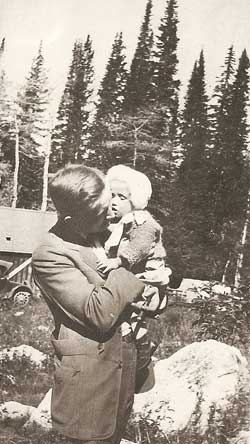
Ross and Brownie 1918
On April 6, 1917 the United States had officially become involved in World War I and on June 5 of that year, Ross registered for the military. In September of 1918 he was called to duty, reporting to Camp Lewis, Washington for training. Shortly thereafter he was transferred to Camp Pike in Arkansas. The war was winding down and the armistice with Germany was signed on November 11, 1918. Ross spent a few more weeks in Arkansas, impatiently awaiting his discharge and the opportunity to return home and resume his work at the Troy Laundry.
In the years that followed, three more children were born to Ross and Norinne; Harold Ross Jr. "Jack", September 13, 1919, Janet, August 19, 1921 and James Thompson "Jim", March 16, 1927.
Through the earliest years of Balsam Hill, Ross seemed to have developed a clear passion for Brighton. It seems only natural he would want to expose his new family to what gave him so much pleasure while he was growing up.
In January of 1933, a year following James H. Brown's death, the ownership of Balsam Hill Cabin and his other real estate holdings were transferred to the newly formed Brown Corporation of Utah; the incorporators and stockholders being the seven Brown children. Ross, Marjorie and Ted were designated as the officers.
According to Janet and Jim, Ross and Norinne always offered the cabin to Ross's siblings, for their use, at the beginning of each summer. The offer was consistently, but politely declined. Creighton was still residing in California and the others visited occasionally for a meal and a walk but never stayed overnight. Janet speculated that they thought the cabin was best suited for the children. Ross and Norinne were the only Salt Lake Brown siblings with offspring. Stewardship of Balsam Hill, it appears, was being passed to Ross and Norinne.

L-R: James H. Brown, Brownie, Leoline, Marjorie, Elizabeth, Ross, Lavinia.




Brownie 1918 L-R: with Elizabeth; Near the Annex; Checking Ross' tires; with Marjorie.



L-R: Brownie, Flo and Bobbie; Jack and Brownie 1920; Brownie and Jack.
In the photo on the right, Brownie and Jack (1920) are on the west side of the cabin near where the screened porch sits today. E.D. Woodruff had purchased the lot next door to Balsam Hill Cabin in 1897 the same day that J.H. Brown purchased the Balsam Hill property. That chain of title went from Woodruff to Caine in 1903 to Elise Smith in 1917 to Hogle. Woodruff built the main cabin structure and the Caines built the addition on the back. The whole structure burned after 1920. The current Hogle cabin was built in 1922.


Left Photo: L-R: Ross, Janet, Lavinia, Brownie on August 19, 1922, Janet's 1st birthday
Right Photo: L-R: Brownie, Janet, Jack 1924

Janet, Jack and Brownie helping Ross cut firewood.
While the third generation of the Brown family was focused on growing, there was another cabin in Brighton developing its own inhabitants which eventually had particular significance to Balsam Hill.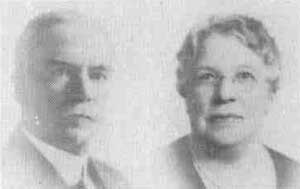
Richard P. and Florence Dinwoody Morris
When Robert Brighton received a patent in 1887 from the United States on the 80 acres, of which part became Silver Lake Summer Resort, he had apparently already made commitments to some prospective buyers of certain choice parcels. On the plat map of 1890, these were labeled as "Reserves". One such Reserve (#4) was purchased by Henry W. Lawrence in August of 1885, but not recorded until May of 1887 after Brighton's patent was recorded. It consisted of 3.15 acres and was located about half way between the Brighton Hotel and Balsam Hill Cabin. In 1894 Lawrence divided that parcel into thirds and sold the middle third to Mariam Brooks and Rosina Godbe. The Brooks and Godbe families built several cabins on the parcel. In May of 1901 they sold one of those cabins and the piece of property on which it sat to Florence Dinwoodey Morris. This cottage was located five to six hundred feet southwest of Balsam Hill Cabin.
Florence Dinwoodey had married Richard P. Morris in 1897. This was a second marriage for both. Florence had first been married to polygamist Rudger Clawson in 1882.Morris had been married previously to Sarah Isaac with whom he had three children: Emma (1886-?), Benjamin (1888-1978) and Rebecca (1890-1905). Sarah died in 1895 at the age of 41.

Ben and Hazel MorrisRichard and Florence had three children together: Russell (1899-1960), Thornton "Spide" (1903-1990) and Marion (1905-1962). Richard's oldest son, Ben, married Hazel Tomlinson in 1910. They in turn had two children, Mary (1913-2007) and Richard Phillips "Dick" born February 28, 1915.
Dick Morris was first introduced to Brighton as a guest of his grandparents, Richard and Florence, in the summers of the late teens and twenties. In the late twenties and early thirties, Dick spent the summers living in a small guest cabin located behind the Morris cottage.
Richard P. "Dick" Morris
Nationally, the decades of the 20's and 30's were an interesting time where extreme ends of the political and economic spectrums were experienced. World War I had ended in 1918 after which the U.S. economy suffered a deep, but brief recession marked by an unemployment rate nearing twenty per cent and runaway inflation. Warren G. Harding became president in 1921 and proposed to reduce the national debt, reduce taxes, protect farming interests, and cut back on immigration. Harding never lived to see it, but most of his agenda was passed by the Congress. These policies led to the "boom" of the Coolidge years, often referred to as the "Roaring Twenties". One of the main initiatives of both the Harding and Coolidge administrations was the rolling back of income taxes on the wealthy which had been raised during World War I. It was believed that a heavy tax burden on the rich would slow the economy, and actually reduce tax revenues. This tax cut was achieved under President Calvin Coolidge's administration.
Another significant event occurred in 1920 when the Eighteenth Amendment to the Constitution became effective on January 16th outlawing the sale, manufacture, and transportation of alcohol for consumption. This was a time commonly called Prohibition and it lasted until December of 1933 when it was repealed by the Twenty-first Amendment. As the twenties wore on and prosperity abounded, the Eighteenth Amendment was increasingly ignored. Establishments which illegally sold alcoholic beverages, called speakeasies, cropped up in many places across the country. Homemade liquor and bootlegging were not uncommon.
Dan Brighton
"In Brighton, during Prohibition", as told by Dick Morris, "one way of finding some liquor was to take a trip up to Dan Brighton's cabin. He greeted you from his front porch and after listening to what you were looking for, Dan declared, 'Well, of course, I don't have any of that stuff, but I did see a sheepherder go by a while ago and I believe he may have had some. Wait here. I'll see if I can catch up to him.' Dan hopped on his horse, headed off in one direction and in a short while he returned from another. He apparently found the old sheepherder because he always had what you came for. Of course, you paid him a little for the service."
The authorities occasionally visited Brighton to enforce the liquor laws. On July 27, 1929 William H. Brighton and a Mr. Bridges were arrested at their cabins for possession of beer.
Salt Lake Tribune July 30, 1929
Another story that occurred during prohibition and told by Dick Morris was about two colorful Brighton characters, Jimmy Whitney and Johnny Bamberger. "One day a couple of 'Feds' (liquor enforcement officers) came into Brighton just doing their job when all of a sudden the horses that were in Jimmy and Johnny's control were mysteriously spooked and nearly ran the Feds down. Apparently, the narrow escape from the charging horses encouraged the Feds to head back down the canyon. Afterwards, Jimmy and Johnny felt terrible about the incident."
Although travel to and from Brighton had improved steadily over what it was in the first part of the century, Brighton was still a community where many families arrived in July and stayed until Labor Day. Lasting friendships were cultivated in those summer days in the 1920's and '30's and the young "Brightonites" and "Brightonettes" grew to know everybody in camp.
In the summer of 1931, Ross and Norinne Brown hired Dick and his good friend Tom Judd,Tom Judd was a grandson of Heber J. Grant, President of the Mormon Church from November 1918 to May 1945. The Grant/Judd cabin is located west of the Big Cottonwood Creek, up on the hill above the "Girls Friendly" now known as Camp Tuttle, the Episcopal Church Camp. Tom and Dick remained good friends until Tom's death in 1977. to paint the wooden roof shingles on the Balsam Hill Cabin. According to Janet, Brownie, then 13, had become quite enamored with Dick and made a point of being constantly available to assist with the painting project in whatever way would be helpful.
to paint the wooden roof shingles on the Balsam Hill Cabin. According to Janet, Brownie, then 13, had become quite enamored with Dick and made a point of being constantly available to assist with the painting project in whatever way would be helpful. 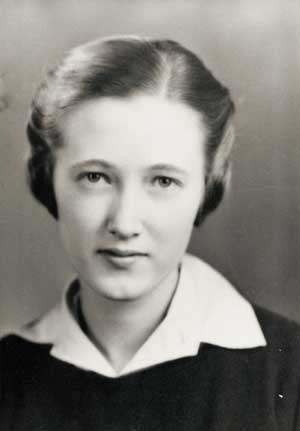
Norinne "Brownie" Brown 1935In other words, she did not dare miss an opportunity to be in his company. At the time, Dick had been going with Patricia Whitney whose family had been long entrenched in Brighton. Pat's diary during those years mentions Dick on an almost daily basis.
On Wednesday July 22, 1931 Pat writes: "... tonight we were all over at the Balsams doing the grapevine. Dick and Tom came in. I had oodles of fun. We danced silly and just acted dumb, but I had loads of fun. Jane and I went up to Brownie's and talked to Dick and Tom while they were painting the roof."
A notation in Pat's diary, on the inside front cover, states that they broke up in January of 1933. But, as is often the case with 17 and 18 year olds, the relationship wasn't really quite over as they continued to see each other frequently. Perhaps, however, the tide was turning in Brownie's favor as Pat writes:
February 28, 1933 "Tuesday, Dick's birthday. I went to the dentist then met Dick. We went out to Coon Chicken, got some specials then went over to Snelgrove's and got a cone and some gum. Later at 2:15 we went to the Victory to see 'Cavelcade'. It was good. We came home. Dick came in for a few minutes. Gee we had fun. Later Dick called me to see if I would take a walk. We did. We walked down to see Brownie. Gee he acted so pepped up after and happy. It made me mad. We got kind of mad. He left. Gee I felt terrible after. I just love him. I hope everything will be OK tomorrow. Cried myself to sleep."Diary courtesy of Pat Whitney Pomeroy's granddaughter, Anne Holman.
Following graduation from East High School in 1932, Dick attended the University of Utah (1933-1935). He worked for the Salt Lake City Water Department for a couple of these summers, keeping an eye on the Lake Mary and Twin Lakes dams and regulating the flow from each. The exact years and the scope of his duties are not exactly known as the City no longer maintains records indicating the dates of his employment. He may have even lived at least one summer in the little log cabin located near the Lake Mary dam, although nothing has been found confirming that impression given many years ago. It was also during these years that Dick and Tom Judd became the self-appointed Sherriff and Mayor of Brighton, respectively. In the early 1970's this appointment was still remembered by one of Dick's friends when they sent him a shiny Sherriff's badge as a gift.
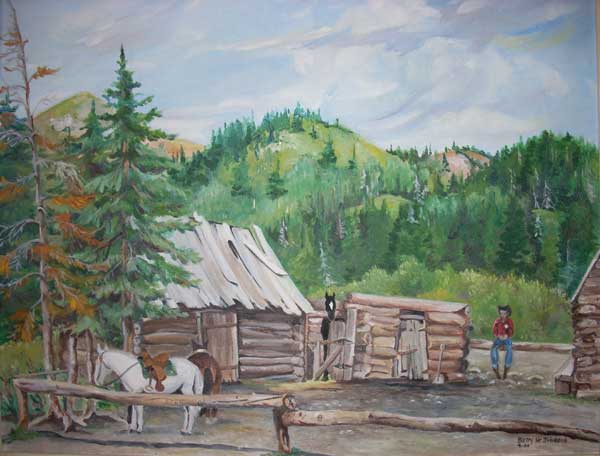
A recollection of Dick Morris at the Green's stables, portrayed as the "Sheriff".
Painting by Betty H. Johnson dated September 1950.
The Brighton Pine Bugle
"The People's Clarion"
The people I have had the opportunity to speak with about the 1930's in Brighton have, without exception, recalled those days as some of the most pleasant in their lives; their voices, smiling with the memories of the Brighton Store, The Balsam Inn, Ern and Molly Green's Stables and the friendships that had become so endearing. I have found no personal letters and only one diary that speaks of the time. Unfortunately the number of people available to lend verbal recollections is now small, but one collection of documents, published in 1936, paints a picture of the days that have been remembered with such fondness.
The publisher of the 1936 Brighton Pine Bugle, Brighton's only newspaper, was Pat Whitney's fifteen year old brother, Frank "Moss" Whitney. The Whitney family had been part of Brighton for a long time. Frank's grandfather, Horace G. Whitney, was one of the original founders of the Silver Lake Water Company in 1910.
Other principals in the publication of the Bugle were Editor-In-Chief, Dick "Buck" Morris, City Editor, "Duster" Richardson and contributing columnist, Dick Whitney. The Bugle, usually just a single sheet, was distributed by staff and friends to cabins. It was also available at the Brighton Store for five cents per issue. It was published almost daily during 1936 beginning the first of July and continuing into August. The collection I have was given to us by Frank's sister, Marion "Meem" Fehr. Most people familiar with the Bugle recall it only being published in 1936, but in the first issue of the collection (the second of the season) is found the story featured below.Reproductions of the actual Brighton Pine Bugle are, in many cases, difficult to read so excerpts have been retyped. For the most part spelling and punctuation have not been altered. The first paragraph indicates the paper had been published in 1935 as well.Frank Whitney's obituary (Deseret News. February 11, 2003) states he published it when he was 13 years old. That would have been in the summer of 1934, so there may have been more years published than remembered.
The first paragraph indicates the paper had been published in 1935 as well.Frank Whitney's obituary (Deseret News. February 11, 2003) states he published it when he was 13 years old. That would have been in the summer of 1934, so there may have been more years published than remembered.
Undoubtedly there are issues missing from this collection, but the flavor of the time is vividly evident. One of the continuous highlights of the 1936 Brighton Pine Bugle was a series of stories written by budding columnist, eight year old Dick Whitney, describing the exploits of space adventurer Buck Rogers.
The Bugle was composed of tongue in cheek stories about people in the village, visitors in camp, poetry, short stories, activities at the stables, an occasional piece of news, gems of advice from "Aching Auricles", sarcasm directed at inconsequential rival papers The Salt Lake Tribune and Telegram, and considerable promotion of the "Biggest event of the season"; the Pine Nuts Ball, to be held on July 29, 1936 at the Balsam Inn.

Brighton Pine Bugle July 5, 6 or 7, 1936
The summer of 1937 marked the most dramatic improvement to Balsam Hill Cabin since the addition of the log kitchen.
From the beginning, the only toilet facility at Balsam Hill was an outdoor privy. Of course, this was standard fare at all cabins in Brighton. Even today some cabins still employ this tried and tested method, although a sewer was finally completed in the canyon in 1997. Most cabins have now hooked up to it including Balsam Hill.
One has to understand a little bit about Norinne to know that enduring twenty years of summer life with a privy is really quite remarkable. Norinne grew up with what most would call the luxuries of the day. Her father was Ezra Thompson, a man quite prominent in mining circles in the late 1800's. He had interests in the Silver King mine in Park City and the primary interest in the Cardiff mine in Big Cottonwood Canyon. He was the mayor of Salt Lake City from 1900 to 1904 and elected again in 1906. He owned beautiful homes on East South Temple and commercial buildings in downtown Salt Lake. Outhouses were not a normal, comfortable way of life for Norinne, but she loved Brighton and accepted the fact that in Brighton it was normal, so she made it as comfortable as possible and tolerated the arrangement.
Balsam Hill Cabin c1915
According to Jim Brown, his mother finally insisted, in 1937, that something had to change. This was when the bathroom was added on the south east corner of the cabin. A sink, shower and toilet were installed that drained in a tank to the west, toward the grove. Inside the main cabin, the stairway leading to the upstairs bedrooms ran from west to east along the south wall to a landing about five feet off the floor. It then turned to the north to the upstairs level. This arrangement required that access to the new bathroom was from under the stair landing through a very short door; less than five feet high. 
Balsam Hill Cabin 1938
with the screened porch added.For Norinne, it was an agreeable inconvenience considering the historic alternative.
Also added at the same time was the 10' x 10' screened porch on the west side of the cabin that looks down to the grove and up at the towering Mount Millicent. This was another improvement that Norinne dearly loved. She spent literally hundreds of hours enjoying it, as have many other people. There may not be, to this day, a single place where more jigsaw puzzles were assembled, books read, naps taken and scrabble games played than on the screened porch of Balsam Hill Cabin. The west window in the downstairs bedroom was enlarged to make room for the French Doors, giving access to the porch.
Included in a packet of papers that has traveled with the various owners of the cabin is a document entitled "EXCERPT FROM MORSE DECREE - BIG COTTONWOOD CREEK" dated April 13, 1914. This is a court ruling insuring the right of named Brighton property owners to use water from the Big Cottonwood Creek during the summer months. On the back of this document is a hand written note stating the cost of the porch and bathroom to be $418.00.
From the earliest days of Ross' exposure to Brighton, he found fishing to be a most desirable pastime. That passion continued through the years until he could no longer make the effort. One of his most treasured activities was to rise early and walk to Silver Lake with his hip boots on and a fly rod in his hand. The sandbar, where the creek enters the lake, was his favorite spot.
Marjorie's birthday celebration, August 4, 1940
L-R Standing: John Henderson, Elizabeth, Pete Hoops (Helen's son),
Leoline, Ted, Helen, Jim, Norinne.
L-R Seated: Marjorie, Janet, Ross, Jack Wading out thirty or forty yards, he surrounded himself with the calm, shallow water and serenity of Silver Lake in the early morning. He was usually successful and brought his catch back to the cabin for the family's breakfast, then headed down the canyon to work.
Along with the growth of a generation comes the demise of the previous one. Creighton succumbed to this reality on January 2, 1938. Although he had spent most of his adult life in Hollywood, he passed away at the home his father built on 39th South. His Salt Lake physician had attended him since June of 1935, but he had been suffering from tuberculosis for over 20 years.Creighton Brown death certificate. His wife, Flo and daughter, Barbara continued to live in Hollywood.
His wife, Flo and daughter, Barbara continued to live in Hollywood.
In the late '30's and early '40's the newest generation of Brown children began scattering about. Jack followed his father and uncles through Hill School in Pottstown, Pennsylvania then received a degree in industrial administration from Yale in 1941. He subsequently received a diesel engineering degree from Cornell University. In April of 1942, he married Louise "Wid" Chamberlain in Washington, DC where he was stationed as a lieutenant commander in the U.S. Naval Reserve.
Janet graduated from Rowland-Hall in 1938. Following her mother's footsteps, she attended Bennett Junior College in Millbrook, New York. Just prior to her marriage to Lieutenant William "Bill" Smith in December of 1942, she graduated from the University of California at Berkeley.
Jim, the youngest of the four, was thirteen in 1940 and the only child at home for a few years until his own attendance at Hill School. Near the end of World War II, Jim spent a year in the Navy. He was discharged in July of 1946. That fall he enrolled at Yale, spent his junior year studying in France and graduated with the class of 1950.




Left to Right:
Norinne "Brownie" Brown Morris 1941
Jack Brown 1940
Janet Brown 1941
Jim brown 1941
In the fall of 1936, Dick Morris went to Chicago
Brownie and David February 1939 to complete his studies at the University of Chicago Medical School from which he graduated in 1939. Nothing exists to indicate if he returned to Salt Lake during the summers after 1936. He was quite involved with his schooling and may very well have stayed in Chicago.
Brownie, a 1934 graduate of Rowland-Hall, attended the University of Utah. In 1937 she enrolled at the University of Wisconsin in Madison; coincidently, closer to Chicago than Salt Lake was. On January 17, 1938, Dick and Brownie were married in Chicago.
After graduation, Dick interned at Presbyterian Hospital in Chicago. He completed research fellowships in the Department of Pathology at the University of Chicago Medical School and in the Department of Endocrinology at Rush Medical College.
Dick and Brownie's first son, David Breck, was born September 2, 1938. Their second son, Terry B. was born December 11, 1941.
Dick's handwritten notes state that he joined the 13th General Hospital of the United States Army in March 1943, but his Army Certificate of Service shows his date of entry as June 15, 1942 in Cook County, Illinois. Another document indicates he was still in the mid-west in 1943.Certificate of appreciation from the State Medical Society of Wisconsin for an exhibit of "Endocrine Regulation of Growth" presented in 1943.
On January 5, 1944 Dick set sail for the South Pacific, completed a course in Tropical Medicine in Sydney, Australia then went to New Guinea, stationed at an Army medical facility. He also spent some time in Luzon, Philippines, returning home to Salt Lake City on November 28, 1945. He was subsequently discharged from the Army on February 23, 1946.
During Dick's service overseas, Brownie and her two young sons lived with her parents at 529 East South Temple along with her sister Janet and her two sons, Steven and Donald. 
Dick and David 1943Janet was pregnant with Don when her husband, Bill, was killed in action in France on November 22, 1944.Salt Lake Tribune December 9, 1944; pg 17.
Life continued on in Brighton during the war years. It was, however, a hectic time, so no one seems to recall if the Brown visits to Balsam Hill Cabin were for the full summer or simply brief periods.
Meanwhile, after twenty five years of sitting idle, James D. Moyle had concerns the deteriorating Brighton Hotel was becoming a serious fire hazard. He decided to have the historic structure torn down in 1945. Henry Florence, the proprietor of the Alpine Rose, purchased the building, did the demolition and used the lumber in the expansion of his establishment at the base of the Majestic ski run.Although a significant part of the Brighton landscape, the Alpine Rose has not been featured in this history. Penny Florence Tolman, daughter of Henry Florence, has compiled a wonderfully detailed history of her father and the Alpine Rose Lodge, "Henry S. Florence, Ten Years at the Alpine Rose Lodge", March, 1978


The Brighton Hotel just before and during demolition. 1945
Photos courtesy of Adrienne Aldous and the Moyle Family Collection
"Henry Florence sold the lodge to Dr. Guy Wight on October 15, 1954. After a succession of owners and operators, who were out for the fast buck rather than serving the public in a beautiful alpine setting, the lodge burned to the ground on June 4, 1965 at 9:30pm. The fire started in a long accumulation of garbage in the basement and quickly spread upward through the wooden structure.
"The fire chief at Station #1, when contacted in 1977 for details, said the fire was still in litigation and that he could not legally discuss it. He implied that the lodge had been stripped of valuable equipment and then set afire.
"A modern structure of concrete and timber has now been built on the site of the old Alpine Rose."Epilogue from Penny Florence Tolman's "Henry S. Florence, Ten Years at the Alpine Rose Lodge"

Alpine Rose Lodge
Photo courtesy of Adrienne Aldous and the Moyle Family Collection
In order to paint a complete picture of life at Balsam Hill Cabin during this era, one person must be mentioned, not only in connection with Brighton, but also with Ross and Norinne's family in general. In 1928 Borghild NielsenBorg's parent's names were Olaf and Louise Baardsen. was hired as a cook for the Brown family, then living at 551 East South Temple. Borg was born on July 29, 1894 in Drammen, Norway. She immigrated to the United States in October of 1927.Passenger list from the ship "S.S. Frederik VIII" from Oslo, Norway to New York, NY. Arrival date: October 17, 1927. Borg is listed as Borghild Nielsen, marital status: single; mother's name: Louise Baardsen; Birthplace: Drammen, Norway; Final destination: Salt Lake City, Utah.
was hired as a cook for the Brown family, then living at 551 East South Temple. Borg was born on July 29, 1894 in Drammen, Norway. She immigrated to the United States in October of 1927.Passenger list from the ship "S.S. Frederik VIII" from Oslo, Norway to New York, NY. Arrival date: October 17, 1927. Borg is listed as Borghild Nielsen, marital status: single; mother's name: Louise Baardsen; Birthplace: Drammen, Norway; Final destination: Salt Lake City, Utah. A follower of the Mormon religion, she came to Salt Lake as a result of those convictions. She was employed by Ross and Norinne until her death on November 5, 1974, but could, and should really, be considered a member of the family.
A follower of the Mormon religion, she came to Salt Lake as a result of those convictions. She was employed by Ross and Norinne until her death on November 5, 1974, but could, and should really, be considered a member of the family.
Jim spoke about Borg with distinct affection. "She was a great influence for me. She really was a surrogate mother. As a child, I remember if I woke up with a bad dream I would go into her room and not in my parent's room."
Jim, an ordained Episcopal priest, was asked to speak at Borg's funeral. Afterward a man came up to him and said, "Jim you're too good not to be a Mormon." Jim wasn't quite sure how to take that compliment, especially knowing that he and Borg used to have very lively discussions regarding religion. "She was quite a strong Mormon", said Jim. "We argued about that a great deal. Until we finally decided we loved each other too much for us to get caught up in that whole subject matter. We really did love each other in a very deep way."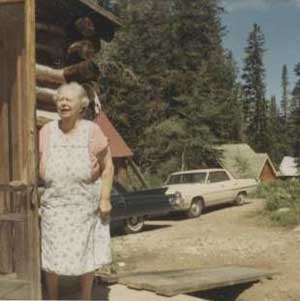
Borg on the porch of the kitchen (her domain)
1962
Janet punctuated the relationship Jim and Borg had. "They used to have the strongest religious arguments. She couldn't understand why he couldn't see it her way and he couldn't understand the same about her. She really raised Jim. It was like he was her son. They had a very special relationship."
In the thirties, Borg was an invaluable part of the household, especially in Brighton. The children frequently had friends staying with them, creating quite a large group to cook for. The kitchen still had the wood burning cook stove that was installed in 1910. Maintaining a constant heat for baking cakes and other dishes was a bit of an art. "How Borg put up with the crowds she cooked for I'll never know", wondered Janet, "always so much food for everybody. Before the bathroom was added on, as kids we'd take our baths in those big brown tubs in the kitchen splashing water all over her kitchen while she kept the fire going and the bathwater hot. But, she never complained. Before she married Pete StromnessBorg's obituary, indicates she married Pete in 1932. Salt Lake Tribune November 7, 1974 pg 30. she slept upstairs where my friends and I would be talking and giggling at night. She would say 'Girls, can't you be quiet? I have to have my sleep!' That was the only thing she ever complained about that I recall. After she married Pete they stayed in the Annex.The Annex was the original framed cabin, attached to the log house that served as the kitchen until about 1915, then moved to make room for the log kitchen.
she slept upstairs where my friends and I would be talking and giggling at night. She would say 'Girls, can't you be quiet? I have to have my sleep!' That was the only thing she ever complained about that I recall. After she married Pete they stayed in the Annex.The Annex was the original framed cabin, attached to the log house that served as the kitchen until about 1915, then moved to make room for the log kitchen. Pete chopped wood and did other chores around the cabin. He was a tall, strong Norwegian about 25 years older than Borg."
Pete chopped wood and did other chores around the cabin. He was a tall, strong Norwegian about 25 years older than Borg." 
Rod splitting wood for Borg's fire
while she keeps a watchful eye from the kitchen.
Pete died in December of 1952, but Borg still continued her role in Brighton cooking for the Browns and rooming in the Annex. She also did a lot of work for the Mormon Church, serving as a translator and working for their genealogy department. She spent what free time she had in the Annex working on that effort. In the sixties, she had newspapers and documents spread from one end of the Annex to the other, clipping obituaries and compiling other relevant genealogical information.
Borg had the physique of a cook who enjoyed her work. Through a child's eyes that ampleness was probably magnified. One summer evening, after the extended family had consumed a large turkey dinner that Borg had prepared, my brother, Chad, and I drifted into the kitchen while the adults continued discussing topics I'm sure we deemed to be boring. We were quite young, and when we entered the kitchen we saw Borg sitting on her high chair that was always available to offer a temporary rest from being on her feet so much of the day. On the table in front of her was what was left of the turkey after feeding a large number of guests. Considering her girth and a stripped turkey carcass within her reach, we asked, with our eyes wide and mouths dropped in disbelief, "Borg, did you eat that whole thing?" She looked at the turkey and realizing what we must have assumed, turned back at us smiling and said with her pronounced Norwegian accent, Why yes boys, I did."
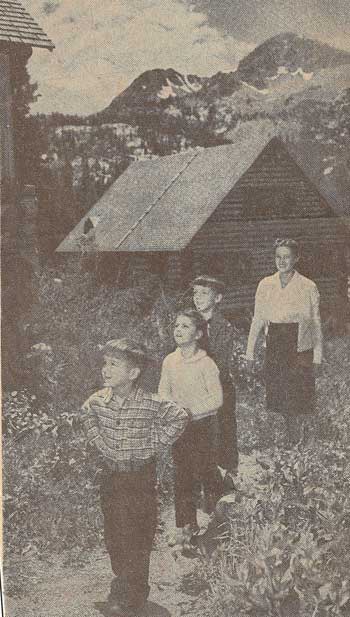
Terry, Heidi Ellerbeck, David and Brownie.
Heidi is the daughter of Dick's sister Mary.
Salt Lake Tribune July 21, 1946
The war was over, Dick had returned home to Brownie, David and Terry and he began his medical practice. He set up his first office in the Boston Building in downtown Salt Lake City and began the business of getting back to normal after the nation was interrupted by a World War.
Dick joined the staff at Holy Cross Hospital in 1947. He also became a clinical instructor at the University of Utah, a position he held until 1958. One of Dick's earliest patients was Ross' youngest sister Leoline who suffered from Rheumatic Heart Disease. As a clear example of generational transition, she passed away on June 15th, 1947, the same day that Creighton's grand daughter, Wendy Martin, was born.
The third son born to Dick and Brownie was Chadwick Brown on December 3, 1948 and the fourth, Rodney Ben, on May 22, 1952.
It's uncertain how much time the Morris' spent in Brighton from 1946 to 1953 with four young boys and a newly hatched medical practice, but in August of 1953 Dick and Brownie purchased their own cabin in Brighton from Mary and Gail Smith. Located six hundred feet to the north of Balsam Hill, their "new" cabin sat on a heavily wooded, half acre lot, next to the creek that runs out of Deadwood Gulch. Who built this framed cabin is unknown, but the Smiths bought it from Minnie J. Whitney in 1951.
The "Yellow Cabin", as it came to be known, was a two bedroom structure. Like most cabins of its day, it was designed for summer usage only. It had no insulation and the interior was simply the exposed structural framework of 2x4s and the rough backside of the exterior siding.
The Yellow Cabin 1965. It had a wood burning cook stove in the kitchen, very similar to the one at Balsam Hill Cabin. Behind a little guest cabin that sat to the south, Brownie found the cast iron pieces of an old coal stove. She meticulously cleaned and reassembled the pieces, restoring the stove to a usable condition. It heated the living room of the Yellow Cabin for many years and continues to warm the interior of Balsam Hill Cabin today.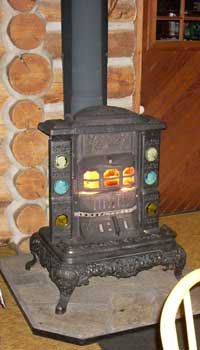
The Peninsular Coal Stove found
in pieces near the Yellow Cabin in 1953.
Dick and Brownie began taking a month every fall beginning mid-September and spent it at the Yellow Cabin. In the fifties and early sixties, the Silver Lake Water Company stopped providing water to cabin owners after Labor Day, so an alternative supply had to be fashioned. One of Dick and Brownie's earliest projects was to develop a spring that existed above the cabin. The original effort included guiding the spring into an old bathroom sink planted in the ground which acted as a small reservoir. A hose connected to the sink's drain pipe served as the conduit to the cabin. Soon they realized that this system wasn't adequate, so Terry was engaged to dig a pit and place a fifty-five gallon drum in it to catch the water emerging from the spring. A small trench was excavated for the overflow to follow and drain into the Deadwood Gulch stream. A garden hose was fastened to the drum, run down the hill and attached to an outdoor faucet, back-feeding the cabin plumbing, providing water for their annual fall visit.
A tradition that Dick and Brownie established during their fall vacations was the "Walking Party". A group of a few very close friendsThe group usually consisted of Tom and Virginia Judd, Marv and Julia Bertoch, Butch and ??? Lund, and Gus and Carol Nicholson. came to the cabin, arriving in the late morning. Dick and Brownie had a nice hike planned and guided the group through the wonderful fall, mountain colors. Along the way they stopped to enjoy a picnic lunch while Dick entertained them with some selected readings; frequently subject matter that he happened to be studying at the time.
came to the cabin, arriving in the late morning. Dick and Brownie had a nice hike planned and guided the group through the wonderful fall, mountain colors. Along the way they stopped to enjoy a picnic lunch while Dick entertained them with some selected readings; frequently subject matter that he happened to be studying at the time.
Dick Morris reading to the Walking Party After returning back to the cabin they all enjoyed some afternoon adult beverages and a terrific dinner that each guest brought a portion of. The annual walking parties lasted until the early 1970s when the ages and health of various participants became a deterrent.
Dick and Brownie and their good friends, Emerson and Marion Sturdevant were enjoying the Yellow Cabin one fall day when the inspiration poured over them to name sections of the Deadwood Gulch stream. They constructed and placed small signs declaring their creations. Starting at the point where the spring drainage ditch intersected with the stream and working down the hill towards the cabin they posted "Breck's Breakers"Breck was David's middle name and the moniker he went by until after he returned from Maryland in about 1960. , then "Terry's Torrent", "Chad's Cascade" and "Rod's Rapids". The final sign was a self-deprecating catch-all for the four adults: "Dopehead's Dribbles".
, then "Terry's Torrent", "Chad's Cascade" and "Rod's Rapids". The final sign was a self-deprecating catch-all for the four adults: "Dopehead's Dribbles".
These fall vacations became my introduction to Brighton at an early age. Chad and I stayed with our grandparents, Ross and Norinne, in Salt Lake during the week so we could attend school. On the weekends we were usually allowed to bring a friend to the cabin and always looked forward to the opportunity.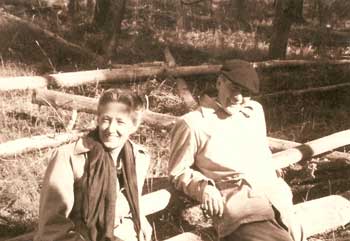
Brownie and Dick enjoying a fall walk in Brighton. It was a time when Dick was noticeably more relaxed. Looking back on it, it's evident that Brighton was a place where he felt comfortable and not so consumed by his practice and patients who depended on his attention. More than one of his old friends from Brighton have described how playful he was in the thirties before he went away to medical school and the South Pacific and how he had become so much more subdued afterwards. Perhaps it was those experiences; perhaps it was just growing up and having the responsibilities a family bestows or, more likely, a combination of the two that took the playful spring out of his step in their eyes.
"School" was what he called it. After the last of the sausage, pancakes and strips of bacon disappeared on those fall Sunday mornings, but before the table was cleared, Dick rose, walked to the side door of the Yellow Cabin, opened it and rang the brass bell mounted just outside of the door frame. This was the same bell that let us know it was time to return home when we were out exploring streams, discovering new hiding places or unsuccessfully trying to trap squirrels. On Sunday mornings, though, it was an announcement that school was in session. Dick had lessons prepared; often times articles from an old Reader's Digest were the source. He read the stories and then playfully quizzed all at the table on the content. Reader's Digest even provided the questions in some cases, but Dick had a way of enhancing their dry queries. It was fun. It was one example of how Brighton exposed a side of Dick that we rarely saw otherwise; perhaps a glimpse at the lightheartedness his friends knew in the thirties. It padded my growing attraction to Brighton.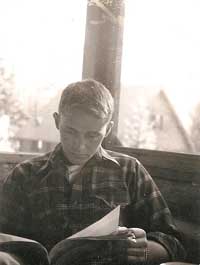
David on the screened porch
about 1958
My oldest brother, David, was fourteen years my senior, Terry ten. I never really got to know either of them until later in my life. They spent their earliest days growing up through the war years and developed in a totally different environment than did Chad and I. By the time I was effectively conscious, David was in college, then in the Coast Guard stationed in Maryland, then married. I knew him primarily from photographs; not unlike an imaginary friend. Terry wasn't far behind David. Consequently, my recollections of Brighton in the fifties and sixties have very sketchy inclusions of my oldest brothers. Their stories of Brighton may easily draw significantly different pictures than mine.
Ross and Norinne, (Papa and Neen as we always called them), were still regulars in Brighton every summer. When we came up to the Yellow Cabin, it was always an agenda item to take the shortcut (every trail is a shortcut) over to Balsam Hill to visit.
Janet married Bob Oakford in 1948. They lived in California with Janet's first two sons, Steve and Don and had a son named Fred, born in 1949. Some years their summer vacation was to Salt Lake which included some time in Brighton. Jack and Wid had three daughters, Gretchen (1944), Kif (1949) and Norin (1953), all living in Salt Lake. It was always something to look forward to when some or all of the cousins could congregate at Balsam Hill, highlighted by a night time bonfire and a marshmallow roast, maintaining the tradition established more than a half century before.



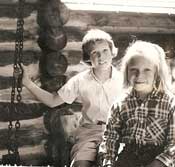
Photos Left to Right:
Gretchen Brown, Terry Morris, Steve Smith, Don Smith 1954
Kif Brown, Fred Oakford, Chad Morris, Brownie 1954
Ross, Rod Morris, Chad Morris, Fred Oakford 1954
Kif Brown, Norin Brown 1958

L-R: Gretchen, Neen, Fred, Don, Steve, Janet, Bob Oakford. About 1958
I had anchors in Brighton. I was attached to two cabins by family and a long trail of history yet to be discovered. Brighton was a summer way of life, one of those assumed ventures of childhood that just dependably happened. The activities were simple, always including a slip into the inlet creek at Silver Lake and rounding up a few tadpoles from the outlet. We rarely came back to the cabin with dry shoes. Learning to shoot the pellet gun was a favorite. Dick was very careful to teach us the proper way to handle a gun, using the uphill slope behind the Yellow Cabin as a backstop; the tin cans set up on an old 2x4 for targets.
Hikes with a picnic lunch were common. One of my favorites was the walk up Deadwood Gulch, always in search of the hidden lake at the top and the little old log mining cabin near it. The small lake dries up in late summer, but can be seen for a while after the final spring snow has melted. The cabin is now withered away with very little sign that it existed at all. Another was the walk to Lake Mary and on to Martha. Dick had us nearly convinced there really was a man who lived on the island in the middle of Lake Martha. His name was Herman the German, Dick said, although he pronounced it "Hoyman the Joyman". We always looked at Brownie with a skeptical eye hoping for confirmation or denial, but neither ever came; only a smile met our glances. The same look was thrown Brownie's way when Dick told us about the Aspen trees that bowed almost back to the ground. They were that way, he said, because he used to tie a rope to the top of a straight tree, pull the rope tight, bending the tree into a powerful spring, the same way a bowstring loads a bow, then loop the rope on the ground ready to snare the first bear that happened by. The poor tree became so fatigued from the weight of a trapped bear that it was never able to straighten back up.
"Batching it" was a privilege granted when we turned fourteen. This meant we had received our merit badges, of sorts, for cabin care, fire building and putting things back where they belonged. Dick and Brownie trusted us to stay at the Yellow Cabin with a friend for a summer weekend, un-chaperoned. Brownie took us to the grocery store to purchase our food for the weekend based on the menu we designed, drove us to the cabin, made sure we understood the rules and left us to our own devices; to sink or swim. The Emancipation Proclamation was actually readable in the glow of her tail lights as she pulled away from the cabin, turning right onto the highway heading back down the canyon. No major calamities occurred during these sojourns. Dick and Brownie's good judgment was confirmed.
Growing up I remember no negatives about going to Brighton except perhaps the occasional car sickness going up the old windy road that followed the Big Cottonwood Stream for a lengthy while. Sometimes we were disciplined for doing things that children do and deserve to be disciplined for, but that would have occurred no matter where we were. I'd like to think that being in Brighton might have influenced Dick and Brownie to use a softer switch.
Balsam Hill Cabin sits at an elevation of 8,732 feet above sea level. Many people, as they age, become victims of the thinner air at this elevation. It can become much more difficult to catch your breath with even the most minimal exertion. The difficulty of a short stroll, bringing in firewood or an easy walk to go fishing at Silver Lake begins to erode the pleasure and practicality of the high mountain environment. Such was the case with Ross. In the summer of 1967 Ross was 80 years old, having experienced some heart problems in the few years prior. Norinne was 76. It became evident that their ability to enjoy the cabin as they had for the last fifty years was coming to an end. Their desire was still there, but Ross' health dictated that they not be.
The ownership of Balsam Hill had been in the hands of The Brown Corporation of Utah since 1933. By 1967, the seven original shareholders had become four. After Creighton's death in 1938 his shares were presumably passed to his wife, Flo. Leoline died in 1947 and Marjorie in 1961. Their shares were most likely absorbed by the remaining shareholders. There seems to have been little, if any, discussion with Jack, Janet, Jim or Bobbie about their possible interest in ownership of Balsam Hill. Whatever the circumstances, the remaining stockholders made the decision to sell the asset to Dick and Brownie Morris.
On August 31, 1967, Balsam Hill Cabin was placed into the care of the builders' granddaughter and her husband, both of whom had cultured a genuine, life-long affection for Brighton, as had those that owned the aging log structure before them.
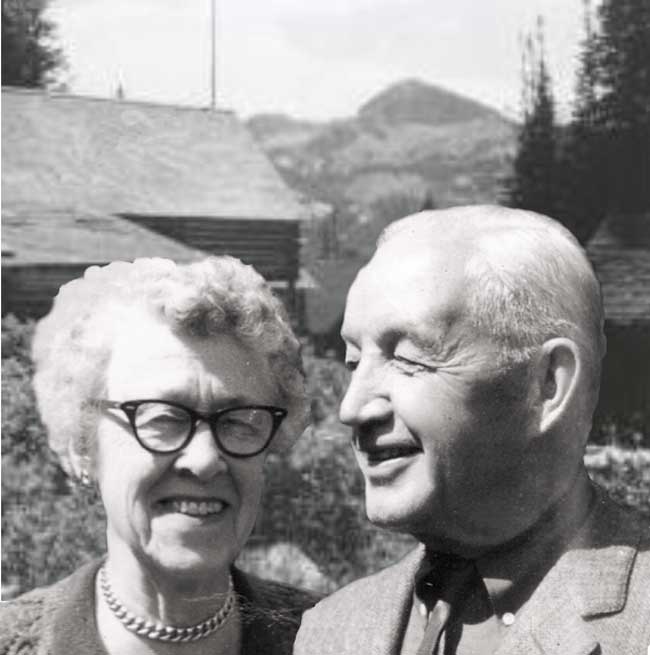
Norinne T. "Neen" and H. Ross "Papa" Brown
1 In a notebook belonging to Emily Pugsley Thompson, the date of death for her daughter Emily is August 7, 1886, but contains a notation from NBM (Norinne Brown Morris) of a corrected date of 1891.
2 See APPENDIX P - Harold Ross Brown Military Registration Card.
4 See APPENDIX O; the Rudger Clawson story.
5 Tom Judd was a grandson of Heber J. Grant, President of the Mormon Church from November 1918 to May 1945. The Grant/Judd cabin is located west of the Big Cottonwood Creek, up on the hill above the "Girls Friendly" now known as Camp Tuttle, the Episcopal Church Camp. Tom and Dick remained good friends until Tom's death in 1977.
6 Diary courtesy of Pat Whitney Pomeroy's granddaughter, Anne Holman.
7 The entire Brighton Pine Bugle collection is available in a separate document in its original form.
8 See APPENDIX K - the history of the Silver Lake Water Company.
9 Reproductions of the actual Brighton Pine Bugle are, in many cases, difficult to read so excerpts have been retyped. For the most part spelling and punctuation have not been altered.
10 Frank Whitney's obituary (Deseret News. February 11, 2003) states he published it when he was 13 years old. That would have been in the summer of 1934, so there may have been more years published than remembered.
11 Creighton Brown death certificate.
12 Certificate of appreciation from the State Medical Society of Wisconsin for an exhibit of "Endocrine Regulation of Growth" presented in 1943.
13 Salt Lake Tribune December 9, 1944; pg 17
14 Although a significant part of the Brighton landscape, the Alpine Rose has not been featured in this history. Penny Florence Tolman, daughter of Henry Florence, has compiled a wonderfully detailed history of her father and the Alpine Rose Lodge, "Henry S. Florence, Ten Years at the Alpine Rose Lodge", March, 1978
15 Epilogue from Penny Florence Tolman's "Henry S. Florence, Ten Years at the Alpine Rose Lodge"
16 Borg's parent's names were Olaf and Louise Baardsen.
17 Passenger list from the ship "S.S. Frederik VIII" from Oslo, Norway to New York, NY. Arrival date: October 17, 1927. Borg is listed as Borghild Nielsen, marital status: single; mother's name: Louise Baardsen; Birthplace: Drammen, Norway; Final destination: Salt Lake City, Utah.
18Borg's obituary, indicates she married Pete in 1932. Salt Lake Tribune November 7, 1974 pg 30.
19 The Annex was the original framed cabin, attached to the log house that served as the kitchen until about 1915, then moved to make room for the log kitchen.
20 The group usually consisted of Tom and Virginia Judd, Marv and Julia Bertoch, Butch and ??? Lund, and Gus and Carol Nicholson.
21 Breck was David's middle name and the moniker he went by until after he returned from Maryland in about 1960.